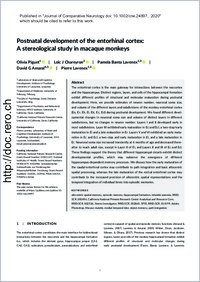Postnatal development of the entorhinal cortex: a stereological study in macaque monkeys
- Piguet, Olivia Laboratory of Brain and Cognitive Development, Institute of Psychology, University of Lausanne 1015 Lausanne Switzerland
- Chareyron, Loïc J. Department of Medicine, University of Fribourg 1700 Fribourg Switzerland
- Banta Lavenex, Pamela Laboratory of Brain and Cognitive Development, Institute of Psychology, University of Lausanne 1015 Lausanne Switzerland - Faculty of Psychology, Swiss Distance University 3900 Brig Switzerland
- Amaral, David G. Department of Psychiatry and Behavioral Sciences, MIND Institute, University of California Davis California 95616 - California National Primate Research Center, University of California Davis California 95616
- Lavenex, Pierre Laboratory of Brain and Cognitive Development, Institute of Psychology, University of Lausanne 1015 Lausanne Switzerland - Department of Medicine, University of Fribourg 1700 Fribourg Switzerland
-
05.03.2020
Published in:
- Journal of Comparative Neurology. - 2020, vol. 528, no. 14, p. 2308-2332
English
The entorhinal cortex is the main gateway for interactions between the neocortex and the hippocampus. Distinct regions, layers, and cells of the hippocampal formation exhibit different profiles of structural and molecular maturation during postnatal development. Here, we provide estimates of neuron number, neuronal soma size, and volume of the different layers and subdivisions of the monkey entorhinal cortex (Eo, Er, Elr, Ei, Elc, Ec, Ecl) during postnatal development. We found different developmental changes in neuronal soma size and volume of distinct layers in different subdivisions, but no changes in neuron number. Layers I and II developed early in most subdivisions. Layer III exhibited early maturation in Ec and Ecl, a two‐ step/early maturation in Ei and a late maturation in Er. Layers V and VI exhibited an early maturation in Ec and Ecl, a two‐step and early maturation in Ei, and a late maturation in Er. Neuronal soma size increased transiently at 6 months of age and decreased thereafter to reach adult size, except in Layer II of Ei, and Layers II and III of Ec and Ecl. These findings support the theory that different hippocampal circuits exhibit distinct developmental profiles, which may subserve the emergence of different hippocampus‐dependent memory processes. We discuss how the early maturation of the caudal entorhinal cortex may contribute to path integration and basic allocentric spatial processing, whereas the late maturation of the rostral entorhinal cortex may contribute to the increased precision of allocentric spatial representations and the temporal integration of individual items into episodic memories.
- Faculty
- Faculté des sciences et de médecine
- Department
- Département de Médecine
- Language
-
- English
- Classification
- Biological sciences
- License
-
License undefined
- Identifiers
-
- RERO DOC 328476
- DOI 10.1002/cne.24897
- Persistent URL
- https://folia.unifr.ch/unifr/documents/308665
Statistics
Document views: 115
File downloads:
- pdf: 266
